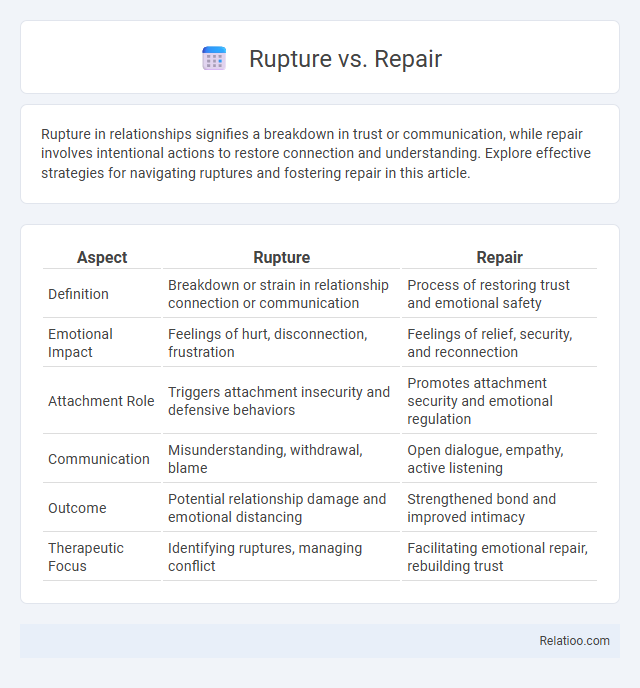Rupture in relationships signifies a breakdown in trust or communication, while repair involves intentional actions to restore connection and understanding. Explore effective strategies for navigating ruptures and fostering repair in this article.
Table of Comparison
| Aspect | Rupture | Repair |
|---|---|---|
| Definition | Breakdown or strain in relationship connection or communication | Process of restoring trust and emotional safety |
| Emotional Impact | Feelings of hurt, disconnection, frustration | Feelings of relief, security, and reconnection |
| Attachment Role | Triggers attachment insecurity and defensive behaviors | Promotes attachment security and emotional regulation |
| Communication | Misunderstanding, withdrawal, blame | Open dialogue, empathy, active listening |
| Outcome | Potential relationship damage and emotional distancing | Strengthened bond and improved intimacy |
| Therapeutic Focus | Identifying ruptures, managing conflict | Facilitating emotional repair, rebuilding trust |
Understanding Rupture and Repair
Understanding rupture involves recognizing the breakdown in communication or trust within relationships, which disrupts emotional bonds and creates conflict. Repair refers to the intentional actions taken to restore connection, clarify misunderstandings, and rebuild trust after a rupture occurs. Effective repair strategies include active listening, empathy, and open dialogue, which are essential for healing relational ruptures and fostering resilience.
The Psychology Behind Rupture
The psychology behind rupture centers on the disruption of trust and emotional connection within relationships, often resulting in feelings of vulnerability, hurt, and disconnection. Rupture triggers defensive mechanisms and cognitive biases, influencing partners' perceptions and communication patterns. Understanding the psychological impact of rupture is crucial for effective repair strategies that restore empathy, rebuild trust, and promote emotional healing.
Common Causes of Relationship Rupture
Common causes of relationship rupture include communication breakdown, lack of trust, and unresolved conflicts that create emotional distance. External stressors such as financial difficulties, infidelity, and divergent life goals often trigger significant strain between partners. Addressing these issues early with effective communication and counseling can prevent further damage and promote relationship repair.
Signs and Symptoms of Emotional Rupture
Emotional rupture manifests through signs such as intense feelings of betrayal, withdrawal, and communication breakdown between individuals. Symptoms include heightened anxiety, irritability, and persistent emotional distance that disrupt relational harmony. Recognizing these indicators early is crucial for facilitating effective repair and restoring trust.
The Importance of Addressing Ruptures
Addressing ruptures promptly is essential for maintaining trust and effective communication in therapeutic and interpersonal relationships. Unresolved ruptures can escalate conflicts and hinder emotional healing, leading to increased relational tension and decreased cooperation. Repair strategies, such as open dialogue and empathetic listening, are vital to restoring connection and fostering resilience after ruptures occur.
Steps to Facilitate Repair in Relationships
Steps to facilitate repair in relationships include active listening to understand each other's feelings and perspectives deeply, which builds empathy and trust. Apologizing sincerely and taking responsibility for actions validation Your partner's emotions and paves the way for healing. Establishing clear communication boundaries and setting mutual goals promotes ongoing collaboration to prevent future ruptures.
Communication Strategies for Healing
Effective communication strategies for healing after a rupture involve transparent dialogue, active listening, and validation of emotions to rebuild trust and understanding. Repair focuses on addressing misunderstandings, expressing empathy, and collaboratively developing solutions to restore connection and reduce conflict. You need to prioritize openness and emotional safety in conversations to foster genuine reconciliation and strengthen relational bonds.
The Role of Apology and Forgiveness
The role of apology and forgiveness is crucial in navigating rupture and repair within relationships, as genuine apologies facilitate emotional healing and rebuild trust. Repair processes that involve sincere acknowledgment of harm can transform ruptures into opportunities for growth, enhancing relational resilience. Your ability to offer and accept forgiveness actively shapes the trajectory from rupture to renewed connection.
Long-Term Benefits of Successful Repair
Successful repair of ruptures in tissues such as ligaments or tendons significantly enhances long-term joint stability, reducing the risk of chronic pain and recurrent injury. Restoring the integrity of the affected structure promotes more efficient biomechanics, which supports improved functional performance and lowers the likelihood of osteoarthritis development. Studies demonstrate that patients achieving complete repair experience better mobility and quality of life compared to those undergoing repeated rupture events without effective intervention.
Preventing Future Ruptures in Relationships
Preventing future ruptures in relationships requires recognizing early signs of conflict and addressing underlying issues through open communication and empathy. Repair strategies involve active listening, validation of feelings, and collaborative problem-solving to rebuild trust and emotional safety. Consistently applying these practices strengthens relational resilience, reducing the likelihood of repeated ruptures and fostering long-term connection.

Infographic: Rupture vs Repair
 relatioo.com
relatioo.com